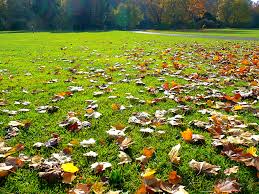Lawn Fertilizing and Liming
Take care of your lawn with fertilizer and lime. Depending on the ground and the target you fertilized with organic or artificial fertilizer. Apply lime acidity of the ground level.
Thatching the Grass
Frost out of the ground? Then get your thatching rake or machine out of the barn. With annual liming make the soil lighter so the land is accessible to oxygen, nutrients and water … and also better grass roots.
Check out our post “Thatching Your Lawn” to learn more
Seeding the Lawn
Bare spots in the lawn? A well-known problem. Bare spots in the lawn can be prevented by spreading grass seed across the lawn. Loosen the soil beforehand with aeration, to allow the seed to deeply take root.
Sprinkle Lime on the Yard
Entice your yard from hibernation with lime. Lime improves and enriches the soil and contributes to a beautiful lawn. February – March is the best time to spread lime over your yard.
Fertilize
For a perfect lawn! Fertilizer nourishes and improves the soil. Regular fertilization gives the lawn new strength and ensures a healthy growth of the overall grass.
Our Liquid Lawn Fertilizer Guide offers some guidance.
Mow
Regular mowing of the grass is very important. Leave the clippings on the lawn, like a natural mulch. It contains important nutrients and strengthens the structure of the soil, as it decomposes.
Healthy Soil
A beautiful lawn requires more than weekly mowing . Regularly fertilize and spread lime to enrich your soil. Especially in spring and summer, the grass pulls many nutrients from the soil and these must be replenished. What fertilizer you need, depending on the purpose of fertilization and soil structure in your lawn.

Soil Composition
Sandy soil needs fertilizer other than clay or loam soil. The composition of the soi must be appropriate to the stage of growth of the grass. Always follow the instructions on the package.
Learn more about your Lawn’s Soil here.
Fertilize with Minerals
mineral fertilizer
Mineral fertilization done with fertilizer. Follow these three steps:
- Scarifying : removes thatch and moss and aerate the soil. Water and food easily penetrate again into the soil.
- Testing: with a ground test to measure the acidity of the soil. Bring on the acidity level by spreading lime, see the paragraph on limestone below.
- Fertilizing : the major fertilizers are nitrogen (N), phosphorus (P) and potassium (K). These are in all of our fertilizer products, but in varying proportions. Does your lawn yellow after fertilizing? Then your lawn needs extra nutrients.
Organic Fertilizer
Organic fertilizing is done with natural fertilizers. Follow the same three steps as mineral fertilizer and then these additional steps:
- By sowing grass seeds.
- Leave the grass clippings.
- Sprinkle with planting soil and compost.
Organic fertilizer enriches the soil and soil structure and has a longer duration of action than synthetic fertilizer. The pellets give regular small amounts of nutrients into the soil, making this fertilizer three to a four-month effect. An organic fertilizer will not damage or “burn” the grass when applied immediately after mowing. Fertilize twice a year for a strong and healthy lawn.
Fall Fertilization
Also remember to fertilize in September. With good fall fertilizing you in fact prevent declining quality of the turf and moss again gets a chance to settle.
Timely additional sowing of grass seed and a good autumn fertilization give a lawn bald spots the best boost to themselves before winter weather completely fill with grass.
Our Fall Lawn Prep Guide can provide more insight into your fall lawn needs.
Lime
Lime neutralizes the acids in the ground. The acidity is expressed in pH-value. The acidity of the soil is important for healthy plant growth and therefore also for grass. Measure the pH value with a home test kit.
By ground to make less acid with lime, the soil is lighter and more permeable. So plant roots deeper and stronger. Is better water management and fertilizer are better absorbed. The best time to throw long-acting calcium fertilizer on your lawn is the end of the year. Lime does not rinse away easily and the material can then act all winter. If needed, sprinkle therefore in the spring lime on your lawn.
Keep your lawn healthy by mowing regularly, any lawn you have. So the grass stays nice closed. Mow a newly landscaped lawn and after seeding, the first time when the grass 6 centimetres high. For example, the turf becomes thicker. Grass is taking place in May and August. Mow the lawn growing season certainly one or two times a week.
Mowing on Hot days?
Mowing on hot days with plenty of sunshine on the lawn in the evening. This prevents the bright sun burning the fresh cut grass. Cutting for a beautiful result only mow dry lawn and stop when the grass does not grow. Dead of winter do not have to mow, still in the autumn.
Trimming the lawn edges
Keep track by regularly cutting the edges of your lawn. A small lawn can be cut manually with edging shears or lawn edge shears with battery. Do you have a larger lawn? Use an electric trimmer or battery powered trimmer. A gasoline powered trimmer or brush cutter is recommended for larger lawns and hard to reach places.
To learn more about how to trim your lawn, check out our Lawn Trimmer Guide
Cutting Height
The correct cutting height depends on the use and the type of lawn. Mow too short, the burned grass weakens the turf and moss forms faster. Mow your too high, the coarse grasses are given free rein. Cutting ornamental grass at a height of 2 centimetres, games and sports turf 3 or 4 centimetres.



Comments are closed, but trackbacks and pingbacks are open.